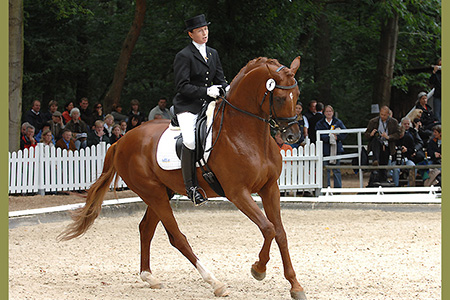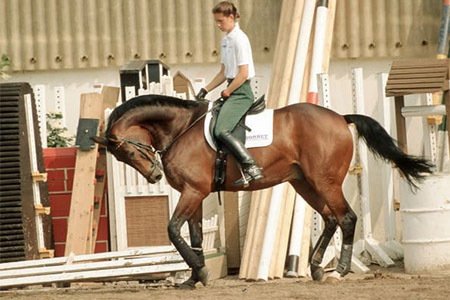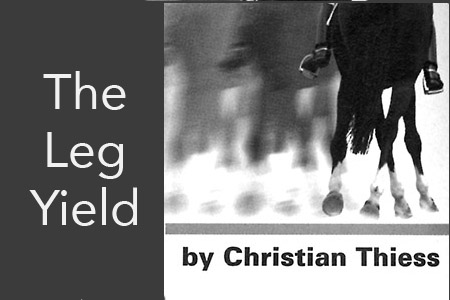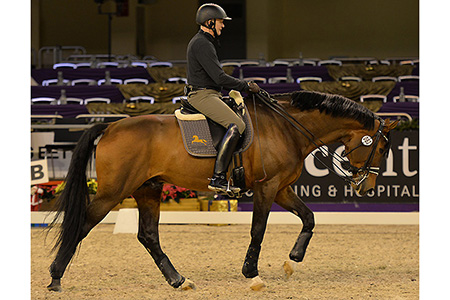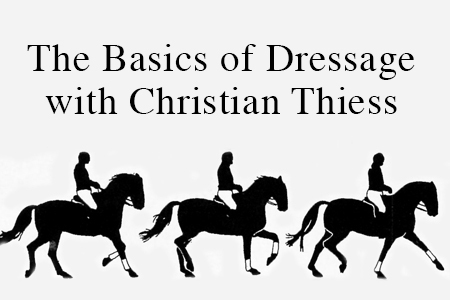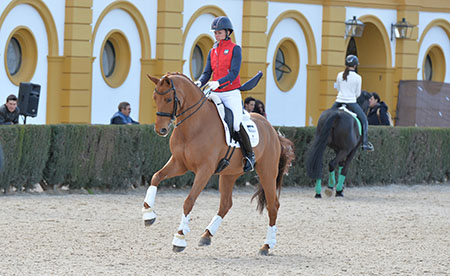Who's Who
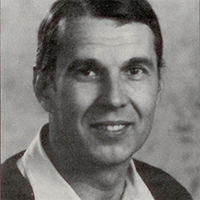
Thiess, Christian
Born : 1937
Died : 2016
By Sarah Milne
The first impression one gains on meeting Christian is his enthusiasm for the riding sport and his outright love of horses. Physically he is tall and slim in the mould of the European sportsman with a powerful handshake and tentative smile. He places great importance on maintaining the highest standards of instruction and speaks candidly about his work and his aims in teaching.
“I have firstly tried to alter the conception of the riders in Australia and New Zealand. I try to make the riders understand that they must instill the basics correctly because only when the horses and riders have a proper foundation can they succeed.”
“Generally the riders in this part of the world are very impatient. They think it is possible to do things in a short time without establishing the horses correctly and before the riders have a true knowledge of riding. It is not possible to prepare the horse until the rider has an understanding and can influence the horse correctly. I try to make the riders realise there are no shortcuts in training a horse. You have to take small steps to achieve the aim and not take one big step and three backwards. That happens in so many cases.”
“I try to pass on an indepth understanding to my students, not just a little surface knowledge. To be able to do this I need to build a continuous instruction and preparation, visiting areas at regular intervals and working with the riders as they progress through the stages.”
“Many riders in New Zealand originally thought they could come for lessons three or four times before a competition and then compete well. Certainly, they made some improvement in this time bur, because there is no time to establish the improvement, when they took part in the competition they forget what they had learned and rode as before. But now the riders are beginning to alter their conception. They are starting to realise how important a continuous preparation is, and through this continuity I am able to concentrate on working through three phases.”
“In the first instance I concentrate on improving the riders because nobody can expect the horses to progress until the riders can function properly. The riders must learn to apply and co-ordinate the aids correctly, in other words they must know how, when and in what intensity to apply them. They must understand the aims of the training and the problems that can be encountered. When the rider has progressed I can concentrate on the horse and rider, and they can make improvements together until the third phase where the rider is really good and I can concentrate on improving the horse with only the occasional correction needed for the rider.”
“I was surprised to find that many of the riders here used to turn their horses out during the winter which is the most important time to prepare the horse. This work is the foundation, and then in the summer months the riders can concentrate on establishing the improvements from the winter and competing.”
Christian is very definite about the aim of dressage training and that it is not something special but rather a correct preparation that preserves and improves the natural ability of the horse. Suppleness, obedience, strength and submission follow.
“I try to broaden the rider’s understanding of the classical art of riding. And the most important requirement of the classical equitation is the purity of the paces of the horse. This can only be achieved from a relaxed, straight horse working with a swinging back and accepting both reins evenly. The hindquarters must be correctly engaged and the impulsion created must flow through the horse. This means through the swinging back, body, poll, mouth and into the rider’s hands, and some of this impulsion must be returned in the same way through the supple poll, back to the hindquarters. The two are related, for if the hindquarters are working correctly they influence and supple the poll and through the suppleness of the poll it is possible to improve the engaging of the hindquarters. My opinion is that any techniques which restrict the impulsion and damage the purity of the paces are a riding crime.”
Many New Zealand riders have commented that Christian’s approach to teaching is so refreshingly precise and easy to comprehend that it brings a new emphasis and understanding to the work. He uses as many teaching methods as possible, including explanations, analogies, demonstrations where one pupil in a group can illustrate a point to the other riders, video evenings, and Christian rides the horses to gain a better understanding of their difficulties to help the riders overcome them.
Christian himself owns four horses which he trains when he has time away from instructing. He hopes to sell them as competition horses when they are established so riders can benefit from riding correctly trained horses. He has worked with various types and has some definite comments to make.
“It is difficult to find a suitable horse for dressage but I am very impressed with many of the thoroughbreds I have seen in Australia and New Zealand. In my opinion the thoroughbred is the King of horses because he has spirit, natural forward urge and intelligence. The problem is the suitable thoroughbreds with spring, good paces and temperament are ideal for racing too, so they can’ t be purchased as young horses at an acceptable price. Instead they are raced and many have their temperaments and soundness damaged by incorrect training.”
“In Germany between the two World Wars there were a lot of thoroughbreds competing in advanced dressage, for example Caracalla XX ridden by Felix Burkner. And, after World War II, I can remember a particularly outstanding horse Brilliant XX, ridden by Willi Schultheis, who achieved the highest dressage level and was a former racehorse.”
“I have had the opportunity to travel a lot around New Zealand to take courses and I have seen many horses including the Hanoverian cross and some look to have good potential. They are at an advantage because their training from the beginning is directed for dressage but I still believe the dressage but I still believe the thoroughbred is the King of the horses. But one mustn’t forget that any horse must be correctly prepared and that is the biggest problem, for without the right preparation no horse can progress.”
Christian competed with considerable success in Horse Trials. Riding a 3/4 thoroughbred stallion Trabant and trained by his father, he won 21 of 22 starts throughout Eastern Europe during five years from 1959-64. A training accident, resulting in torn ligaments in his knee preventing him from rising to the trot and jumping, prematurely ended his competitive career but these have healed with time. However, he is not interested in competing again.
“I believe a good instructor should concentrate entirely on teaching his pupils and preparing their horses because, in my opinion, as a competitor you are not interested in giving your pupils the very best as you will always maintain some knowledge for yourself so you can have the competitive edge. When you are an instructor you should only be an instructor so you are always able and willing to give the utmost to your pupils.”
“In West Germany I saw a lot of well known trainers who prepared riders bur they did not pass on the last derails because they were competing too. As a trainer I wish to transmit as much as possible to my students and I am best able to achieve this when I concentrate entirely on instructing and not competing.”
Christian’s popularity in New Zealand has increased rapidly and in September l983 he was asked to train the Horse Trials squad who were working towards the Los Angeles Olympics. However, it was some surprise to Christian when the training sessions were very limited and the squad did not meet together for any length of time to acclimatize as a team. Christian remembers the beneficial long training camps held for national squads throughout Europe and not surprisingly he is not impressed ·with the New Zealand comparison. He comments:
“I was asked to train the New Zealand Horse Trial squad but I was very disappointed when lack of money limited this training and prevented the Horse Society from sending a trainer with the team to the Olympics. That is one reason I think Australia is the right country where I can really make a special contribution. I am impressed that the Australian national squad trains together for a long period of time and the riders have a chance to establish improvements and build an understanding with their trainer.”
“I think everybody should have an aim in their life and mine is within the next ten years to become the National Trainer for Australia. I realise it will be difficult because there are many talented trainers in Australia and others that visit from overseas, but I have confidence in myself. I have ten years to show the riders that I am the best and that I’m really assist them, and that is why I plan to increase my Australian contacts and give the people an opportunity to get to know me and see my teaching methods. If there is a possibility to shift to Australia then I will, but I will also maintain some contacts with New Zealand as there are many riders here with confidence in me.”
“Eventing is the sport that Australia and New Zealand are closest to world standard in and I think the dressage is progressing. For dressage the people must have a tradition behind them. In Australia, and New Zealand too, the riders are beautiful horsemen, and I was impressed from the beginning by their ability to ride forward, but they haven’t got the background of generations of knowledge behind them and the understanding that to prepare a horse correctly to a high level it takes time and years of patience.”
“What Franz Mairinger did in Australia was a magnificent pioneer work and I have a great admiration for this man and for his special performance to take an unknown country in the riding sport in a few years to win gold and silver medals at the Olympics. He is an idol for me and that is another reason why I should like to continue his work and to build on what he achieved. Franz Mairinger had a classical equitation approach to riding and he made an incredible contribution towards introducing the classical tradition to Australia.”
“Dr Specht has also made a valuable input during his visits to Australia in association with the Haig Dressage competition. He has a profound knowledge, and his lectures and demonstrations are very valuable.”
But while the Antipodes benefit from many visiting instructors, few choose to make these shores their permanent home. We are indeed lucky Christian and his family have settled here and riders can benefit from regular instruction. Christian believes he can make a worthwhile contribution to riding here and after meeting this man one can’t help but realise he has the talent, determination and drive to succeed. But riders be forewarned. His training sessions demand concentration, preparation, and self discipline; but the rewards are proportional.
Christian Thiess- Horseman
West German Christian Theiss has a background of training rarely found in Western countries and unique in New Zealand.
Born in Romania in 1937 Christian lived with his parents on a government show farm on the outskirts of Bucharest. His father, an ex-cavalry officer and former head instructor of a riding school in Hermannstadt, gave Christian the opportunity to ride from an early age, and in his late teens, Christian enjoyed a successful horse trials career, winning international competitions throughout Eastern Europe.
During this time he was a Physical Education student at Bucharest University specialising in riding. The four year course included the study of anatomy, physiology, psychology and biochemistry, and during the first year the riding students each broke in and trained four horses to novice level in all disciplines. In the second year they selected one horse to continue training to medium level and the students were also taught to teach, standing in turn with the instructor while their fellow students rode, before taking over under the instructor’s supervision.
Christian completed his degree in 1964 with the highest qualification and took a teaching position at the University Riding Club. During this time he became increasingly aware of his great love for the demanding sport of dressage, but he never lost his contact with eventing and he later supervised the training of the national horse trials squad and gave instruction throughout Eastern Europe and China, including exchanges with Russia and East Germany.
However, he was disillusioned with the communist system and in 1972 as Romanian Three Day Event trainer at the Munich Olympics he took the opportunity to defect to West
Germany, the country he had always considered his own. After working hard for three years to bring his parents out from Romania, Christian resumed his equestrian career and mentions particularly the influence of George Theodorescu and Dr Wolfgang Holzel. He gained his West German Trainers Licence A, the highest level then available, and in 1976 opened his own riding establishment in Allerheilingin, and also conducted clinics in France, Holland and Belgium.
But after his experience of living in an occupied country and with the political situation in Germany and the ever-present communist threat, Christian wanted a safe place to bring his wife, Monica, and young family to. He set his sights to Australia and New Zealand, and gained the chance to emmigrate early in 1982 to Hamilton, New Zealand.
Sarah Milne’s article first appeared in the October 1985.

